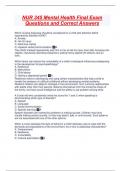Exam (elaborations)
NUR 345 Mental Health Final Exam Questions and Correct Answers
- Course
- Institution
Which nursing diagnosis should be considered for a child with attention deficit hyperactivity disorder ADHD? A. Anxiety B. risk for injury C. defensive coping D. impaired verbal communication B The child's marked hyperactivity puts him or her at risk for injury from falls, bumping into objects, imp...
[Show more]



